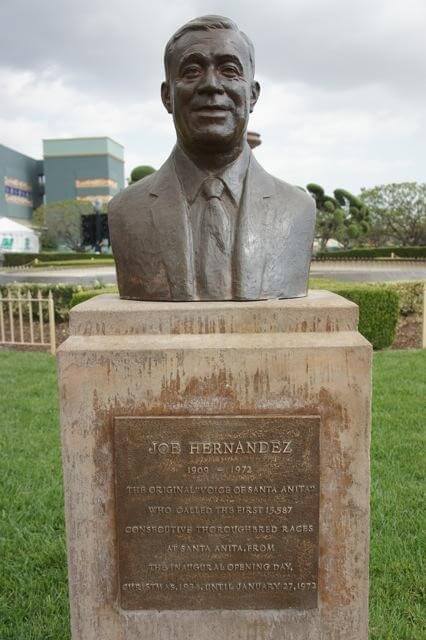Colonel’s Corner
Seabiscuit & Joe Hernandez, The Voice of Santa Anita
by Col Mike Howard
Recently I was asked to share another interview as the Seabiscuit Heritage Foundation Historian. I get these several times a year on a wide range of subjects covering topics which fascinate folks. I try to be gracious so as to honor family heritage and show respect for folk’s loyalty to a wonderful horse. Requests have ranged from: Charles S. Howard & Buick, Hollywood & the Howards, Ridgewood Ranch Memories, Seabiscuit Named Bombers in WWII, Mioland & Nazi Germany, Seabiscuit DNA, Seabiscuit and PTSD, and many others. I always try to do my best which involves searching family records, photos and history. Recently I did an interview on Howard Memorial Hospital (named in memory of Frank Robert Howard, killed on Ridgewood Ranch in 1926). The hospital is an important part of Willits, California, which will soon be celebrating its 100th Anniversary. As I asked my wife Lynn at breakfast: “What do you think is the one most fascinating aspect of this Seabiscuit heritage fascination that keeps people interested?” she immediately responded: “Joe Hernandez and the calling of the 1938 Seabiscuit – War Admiral Match Race.” So I again sat down and listened to this classic recording. It really is amazing in the energy, spontaneity, and professional abilities of this most famous of horse racing “Callers”.
Known most affectionately as “The Voice of Santa Anita”, Joe Hernandez spent most of his professional life working out of the broadcasting booth of Santa Anita Racetrack in Arcadia, California. He faithfully worked there from the time Santa Anita opened on Christmas Day 1934 until he fainted at the microphone on January 27, 1972 and soon after passed away. He was a man who died at his duty station doing what he loved, and many called this a blessing. This was certainly felt by my horseracing addicted Dad, Lindsay C. Howard Jr. who called me as if he had lost a dear friend. In all, Joe Hernandez, according to Santa Anita records, called 15,587 races IN A ROW. That is an incredible testimony to his hard work and dedication behind a microphone in which he had to be focused, prepared, and alert for each entire race! And of course, this also meant being on the road when he called the “Greatest Race of the Century” at Pimlico Race Course, Baltimore, Maryland on Tuesday, November 1, 1938.
Sources at Santa Anita had reported some of the specifics of Joe Hernandez’ passing. In a report much later in February 2016 on the TVG horseracing channel, it was shared that Hernandez had been kicked by a horse earlier and died later while calling a race. Over the course of Hernandez’ career, his cry of “There they go!” echoed over many famous races. These included not just Seabiscuit verses War Admiral in 1938 but also Seabiscuit’s last race winning the Santa Anita Handicap on March 2, 1940. He was there at the Santa Anita microphone when America’s greatest jockey George “The Iceman” Woolf was severely injured by a concussion on 3 January & passed away the next day January 4, 1946 following a fall from his mount ‘Please Me’ (my Father actually witnessed this). Hernandez also called for famous jockey Johnny Longdon’s last ride in 1966.
Joe Hernandez broke into the horseracing business of calling races in 1927 for Agua Caliente Racetrack at Tijuana, Mexico. Many Americans flooded this racetrack across the southern border when official racing (& financial betting) was still illegal in the United States. Historically, professional racehorse “Calling” was developed by the first-ever race caller, Steward George Schilling, who on 5 February 1927 called the first race at the Mexican track. In 1932, Hernandez became the first race caller at Tanforan Racetrack near San Francisco. In the years following, Hernandez became the premiere race caller on the West Coast, at a time when most Mexicans and Mexican-Americans were being repatriated to Mexico due to America’s Great Depression. In the late 1930s, Alfred Vanderbilt Jr. hired Hernandez to call the races at Pimlico Race Course and Belmont Park. While there, Hernandez encountered some discrimination when he was seen in public with his wife Pearl, an Anglo-American. In 1950, Hernandez called the Kentucky Derby for fans at Churchill Downs. His calling of this classic race was later distributed nationwide to over 60,000 racing fans. Folks loved his passion and professionalism.
Joe Hernandez was not only a race caller; he was a highly respected historian on horseracing, a sportswriter, handicapper, trainer, jockey, handicapper, buyer’s agent, radio and television producer, music composer, actor, athlete, and philanthropist. He also owned several businesses related to horse racing. For example, he owned his own film patrol company (a company that recorded races to determine if a foul was committed during a race). Hernandez also imported, owned, and raced Thoroughbreds under his own silks. The most noted race horse to run under his colors was Cougar II, a Chilean import who was inaugurated into the Thoroughbred horse racing’s Hall of Fame in Saratoga Springs, New York, in 2006.
To honor this renaissance man of horseracing, a bronze bust of Joe Hernandez was unveiled at Santa Anita on December 26, 1974. The artwork resides at the bottom of the track’s main grandstand entrance. It was stated by Santa Anita track officials that they decided to place the piece here so Hernandez could be close to his fans, and they appropriately be close to him. As Rudolph Alvarado noted in his biography on Hernandez (The Untold Story of Joe Hernandez: The Voice of Santa Anita), “From here the bust would also serve to introduce Joe, and what he meant to Santa Anita to future racing fans. Most importantly, placed here, Joe’s gaze would always fall on his beloved Santa Anita.”
And to Seabiscuit fans, Joe Hernandez will always share a warm place in our hearts!
